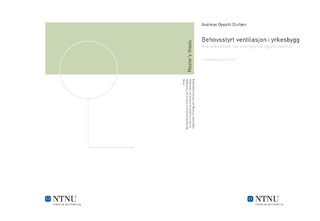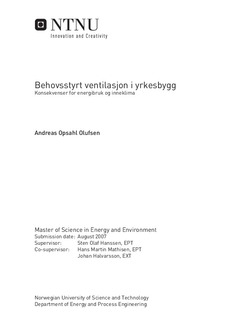| dc.contributor.advisor | Hanssen, Sten Olaf | nb_NO |
| dc.contributor.advisor | Mathisen, Hans Martin | nb_NO |
| dc.contributor.advisor | Halvarsson, Johan | nb_NO |
| dc.contributor.author | Olufsen, Andreas Opsahl | nb_NO |
| dc.date.accessioned | 2014-12-19T11:44:20Z | |
| dc.date.available | 2014-12-19T11:44:20Z | |
| dc.date.created | 2010-09-03 | nb_NO |
| dc.date.issued | 2007 | nb_NO |
| dc.identifier | 347579 | nb_NO |
| dc.identifier | ntnudaim:3692 | nb_NO |
| dc.identifier.uri | http://hdl.handle.net/11250/233582 | |
| dc.description.abstract | There were three main objectives in this thesis. The first objective was to find the utility patent of a building at the Norwegian University of Science & Technology. This was performed using logged data from infrared motion sensor readings over a period of twenty nine days. Main finding suggests an average presence during working hours (8 AM 3 PM) of 57 %. A utility patent developed and based on the twenty nine days of logged data shows the expected occupancy at any time during a normal working day. The second objective, sensor accuracy, is estimated based on comparison of logged data and manual registrations over two days. This information formed a basis for discussion of how well the infrared motion sensors performed. In this building, the conclusion is that ceiling mounted sensors perform better than wall mounted sensors. The third objective is to develop a computer model of the building and simulate it with two different ventilation systems. One simulation is of a CAV system, while the other is a VAV system that is able to adjust its minimum OA requirements according to the registered utility patent found in the first objective of the thesis. The computer model was developed with DOE2. The VAV system proved to perform far more efficient than the CAV system for a one year simulation. The hot water demand was reduced by 51%, cold water by 57%, and fan energy dropped by 76%. | nb_NO |
| dc.language | eng | nb_NO |
| dc.publisher | Institutt for energi- og prosessteknikk | nb_NO |
| dc.subject | ntnudaim | no_NO |
| dc.subject | SIE5 energi og miljø | no_NO |
| dc.subject | Energibruk og energiplanlegging | no_NO |
| dc.title | Behovsstyrt ventilasjon i yrkesbygg: Konsekvenser for energibruk og inneklima | nb_NO |
| dc.type | Master thesis | nb_NO |
| dc.source.pagenumber | 83 | nb_NO |
| dc.contributor.department | Norges teknisk-naturvitenskapelige universitet, Fakultet for ingeniørvitenskap og teknologi, Institutt for energi- og prosessteknikk | nb_NO |

